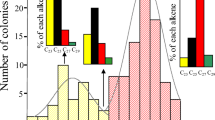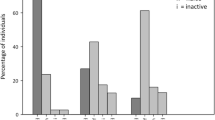Summary
Odontomachus bauri workers recognize conspecifics from other colonies and ants from different species as aliens. Colony specific recognition is based on endogenous odours, present in the different body parts. The chemicals responsible for these odours are volatiles, insoluble in water and soluble in CH2Cl2. No influence of the environment on the recognition signals could be detected. Evidence of intercolony differences in the relative proportions of the different volatile substances of cephalic and abdominal pheromones are presented. Thus, it is postulated that nestmate recognition is based on relative proportions of volatiles produced by the ant in different parts of the body.
On the other hand, evidence of territorial defence is presented. Territorial pheromones, in case they exist in this species, are not necessary for recognition of territories, as is the case in other ant species. The possible relationship between nestmate recognition systems and territorial behaviour is discussed and an evolutionary hypothesis of their development is presented.
Resume
Les ouvrières chezOdontomachus bauri reconnaissent les homospécifiques d'autres colonies et les fourmis d'espèces différentes comme étant étrangères. La reconnaissance spécifique de la colonie est basée sur la présence d'odeurs endogènes dans les différentes parties du corps. Les substances responsables de ces odeurs sont volatiles, insolubles dans l'eau et solubles dans CH2Cl2. On n'a pas pu détecter une influence du milieu sur le système de reconnaissance. On démontre l'existence de différences dans les proportions relatives des substances volatiles des phéromones céphaliques et abdominales entre les colonies. On propose done que la reconnaissance des compagnons du nid est basée sur quelques différences dans les proportions relatives des substances volatiles produites dans les différentes parties du corps.
On présente aussi des preuves de défense territoriale. Contrairement à ce que l'on trouve chez d'autres espèces, le marquage chimique du territoire n'est pas nécessaire pour la reconnaissance du territoire. Finalement, on analyse la possibilité d'une relation entre les systèmes de reconnaissance des compagnons du nid et le comportement territorial, et on présente une hypothèse évolutive sur leurs développements.
Similar content being viewed by others
References
Barrows E.M., Bell W.J., Michener C.D., 1975. — Individual odor differences and their social functions in insects.Proc. Nat. Acad. Sci. U.S.A., 72, 2824–2828.
Bazire-Benazet M., Zylberberg L., 1979. — An integumentary gland secreting a territorial marking pheromone inAtta sp.; morphology, histochemistry and ultrastructure.J. Insect. Physiol., 25, 751–765.
Bell W.J., 1974. — Recognition of resident and non-resident individuals in intraspecific nest defence of a primitively eusocial halictine bee.J. Comp. Physiol., 93, 195–202.
Bradshaw J.W.S., Baker R., Howse P.E., Higgs M.D., 1979. — Caste and colony variations in the chemical composition of the cephalic secretions of the African weaver ant,Œcophylla longinoda.Physiol. Entomol., 4, 27–38.
Buckle G.R., Greenberg L., 1981. — Nestmate recognition in sweat bees (Lasioglossum zephyrum): does an individual recognize its own odour or only odurs of its nestmates?Anim. Behav., 29, 802–809.
Cammaerts M.C., Morgan E.D., Tyler R., 1977. — Territorial marking in the antMyrmica rubra L.Biol. Behav., 2, 263–272.
Cavill G.W.K., Hintenberger H., 1960. — The chemistry of ants IV-Terpenoid constituents of someDolichoderus andTridomyrmex species.Aust. J. Chem., 13, 514–519.
Colmenarès O., 1982. — Estudio del comportamiento de reclutamiento, reconocimiento individual y territorialidad en una hormiga perteneciente a la subfamilia Dolichoderinæ.Tesis de Licenciatura, Universidad Simón Bolévar, Caracas.
Crozier R.H., Dix M.W., 1979. — Analysis of two genetic models for the innate components of colony odor in social hymenoptera.Behav. Ecol. Sociobiol., 4, 217–224.
Dumpert K., 1978. —Das Sozialleben der Ameisen. Verlag Paul Parey, Berlin und Hamburg.
Fielde A.M., 1904. — Power of recognition among ants.Biol. Bull., 7, 227–250.
Forel A., 1874. — Les Fourmis de la Suisse.Nouv. Mém. Soc. Helv. Sc. Nat. Zurich, 26, 447 p.
Greenberg L., 1979. — Genetic components of bee odr in kin recognition.Science, 206, 1095–1097.
Haskins C.P., Haskins E.F., 1950. — Notes on the biology and social behavior of the archaic ponerine ants of the generaMyrmecia andPromyrmecia.Ann. Entomol. Soc. Am., 43, 461–491.
Hamilton W.D., 1964. — The genetical theory of social behaviour, I, II.J. Theoret. Biol., 7, 1–52.
Hangartner W., Reichson J.M., Wilson E.O., 1970. — Orientation to nest-materials by the antPogonomyrmex badius.Anim. Behav., 18, 331–334.
Hölldobler B., 1976. — Recruitment behavior, home range orientation and territoriality in harvester antPogonomyrmex.Behav. Ecol. Sociobiol., 1, 3–44.
Hölldobler B., 1979. — Territoriality in ants.Proc. Am. Philos. Soc., 123, 211–218.
Hölldobler B., Michener C.D., 1980. — Mechanisms of identification and discrimination in social hymenoptera. In:Evolution of Social Behavior, H. Markl editor, Weinheim: Verlag Chemie GmbH, 35–58.
Hölldobler B., Wilson E.O., 1977. — Colony specific territorial pheromone in the african weaver ant.Proc. Nat. Acad. Sci. U.S.A., 74, 2072–2075.
Howse P.E., 1975. — Pheromones and defensive secretions in social insects.Proc. VII Congr. I.U.S.S.I., Dijon.
Jaffe K., 1983. — Chemical communication among workers of the leaf-cutting antAtta cephalotes. In:Social Insects in the Tropics, v. 2, p. 165–180, 1980, P. Jaisson ed., Univ. Paris Nord.
Jaffe K., 1984. — Evolución de los sistemas de comunicación química en hormigas.Folia Entomol. Mexicana (in press).
Jaffe K., Bazire-Benazet M., Howse P.E., 1979. — An integumentary pheromone secreting gland inAtta sp.: territorial marking with a colony-specific pheromone inAtta cephalotes.J. Insect Physiol., 25, 833–839.
Jaffe K., Puche H., 1984. — Colony-specific territorial marking with the metapleural gland secretion in the antSolenopsis geminata (Fabr.).J. Insect Physiol. (in press).
Jaisson P., 1975. — L'imprégnation dans l'ontogenèse des comportements de soins aux cocons chez la jeune fourmi rousse (Formica polyctena).Behaviour, 52, 1–37.
Jaisson P., 1980. — Les colonies mixtes plurispécifiques: un modèle pour l'étude des fourmis.Biol. Ecol. Méditerranéenne, 7, 163–166.
Lange R., 1960. — Uber die Futterwiedergabe zwischen Angehörige verschiedener Waldameisenstaaten.Z. Tierpsychol., 17, 389–401.
Le Masne G., 1952. — Classification et caractéristiques des principaux types de groupements sociaux réalisés chez les invertébrés.Rapport au Colloque international sur la Structure et la Physiologie des Sociétés animales. Paris, mars 1950. Coll. Inter. C.N.R.S. XXXIV.
Longhurst C., 1977. — Behavioural, chemical and ecological interactions between westafrican ants and termites.Ph. D. Thesis, University of Southampton, 1978.
Morgan E.D., Wadhams L.J., 1972. — Gas chromatography of volatile compounds in small samples of biological material.J. Chromatogr. Sci., 10, 528–529.
Provost E., 1979. — Etude de la fermeture de la société de Fourmis chez diverses espèces deLeptothorax et chezCamponotus lateralis.C.R. Acad. Sci., Paris,288, 429–432.
Puche H., 1982. — Algunos aspectos del comportamiento social en la hormigaSolenopsis geminata.Tesis de Licenciatura, Universidad Simón Bolívar, Caracas.
Sanchez C., 1982. — Estudio del comportamiento agonistico en hormigas del generoCamponotus.Tesis de Licenciatura, Universidad Simón Bolívar. Caracas.
Siegel S., 1956. —Nonparametric statistics for the behavioral sciences. McGraw-Hill Kogakusha Ltd, 312 p.
Skinner G.J., 1980. — Territory, trail structure and activity patterns in the wood-ant,Formica rufa in limestone woodland in North-West England.J. Anim. Ecol., 49, 381–394.
Villegas G.J., 1982. — Estudio comparativo de algunos aspectos del comportamiento social de hormigas de los generosTrachymyrmex, Cyphomyrmex yMyrmecocripta.Tesis de Licenciatura, Universidad Central de Venezuela, Caracas.
Weber N.A., 1972. — Gardening ants, the Attines.Am. Philos. Soc., Philadelphia, U.S.A
Wilson E.O., 1971. —The insect societies. Belknap Press, Harvard University, Cambridge, Mass., U.S.A.
Wilson N.L., Diller J.H., Markin G.P., 1971. — Foraging territories of imported fire ants.Ann. Entomol. Soc. Am., 64, 660–665.
Author information
Authors and Affiliations
Rights and permissions
About this article
Cite this article
Jaffe, K., Marcuse, M. Nestmate recognition and territorial behaviour in the antOdontomachus bauri emery (Formicidae: Ponerinae). Ins. Soc 30, 466–481 (1983). https://doi.org/10.1007/BF02223978
Received:
Accepted:
Issue Date:
DOI: https://doi.org/10.1007/BF02223978




